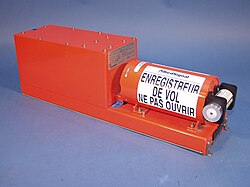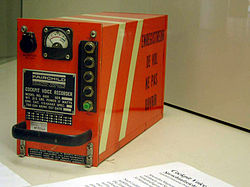Flight recorder

A flight recorder is a recorder placed in an aircraft to help with investigating an aircraft accident or incident. For this reason, they have to be capable of surviving extremely rough treatment. They are usually built to withstand an impact of 3600 g and temperatures of over 1,000 °C (as required by EUROCAE ED-112), because a powerful impact followed by a very hot fire is what often happens in a plane crash.
There are two types of protected Flight Recorder, Flight data recorder (FDR) and Cockpit voice recorder (CVR). In some cases, the two recorders may be combined in a single FDR/CVR unit. The first combined flight recorder was invented by Australian scientist, David Warren.
These recorders are often called "black boxes". They can be used in other vehicles including trains and cars. The car's recorder can monitor the speed of the car or the sharpness of turns. The train's recorder can be used to upgrade after a crash to reduce the chance of another crash.
| Wikimedia Commons has media related to Lua error in Module:Commons_link at line 62: attempt to index field 'wikibase' (a nil value).. |
Flight Recorder Media
A modern flight data recorder; the underwater locator beacon is the small cylinder on the far right. (Translation of warning message in French: "Flight recorder do not open".) The warning appears in English on the other side.
Cold War-era Soviet MS-61 cockpit voice recorder from a MiG-21 interceptor
Flight data recorder recovered from the Potomac River on 2 February 2025, from one of the aircraft involved in the 2025 Potomac River mid-air collision.
A Fairchild A100 cockpit voice recorder, on display in the Deutsches Museum. This is a magnetic-tape unit built to an old standard, TSO C84, as shown on the nameplate. The text on the side in French says "Flight recorder do not open".
"Mata-Hari" Finnish Air Force flight data recorder, 1942
Video clip of 1985 ABC news report interviewing David Warren about his invention
NTSB investigators recover flight data recorder and cockpit voice recorder from UPS Airlines Flight 1354
NTSB staff examine the memory boards of the cockpit voice recorder from Atlas Air Flight 3591. The boards may have suffered water damage.
GEE airborne equipment, with the R1355 receiver on the left and the Indicator Unit Type 62A "black box" on the right.








